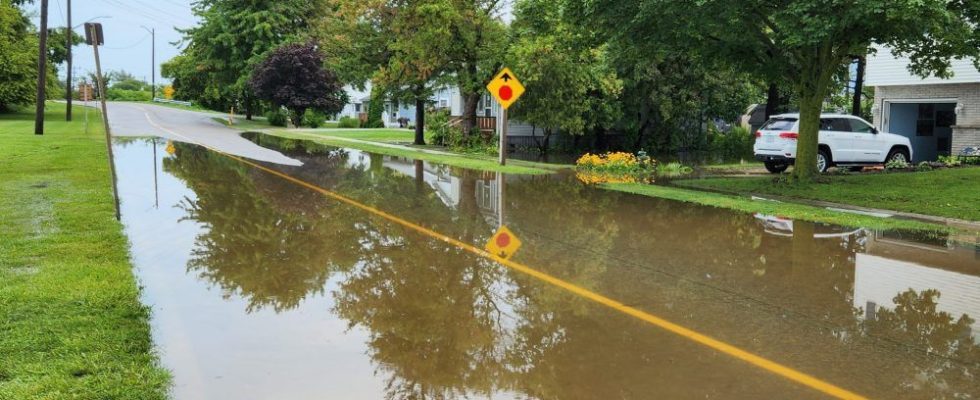
After a year of significant weather events, ranging from ice storms and tornadoes to flooding and heat waves, Chatham-Kent continues to look into protective measures.
Advertisement 2
Last month, the region experienced severe storms, bringing high winds and heavy rainfall. This resulted in damage to public and private property, with ongoing cleanup efforts.
Gabriel Clarke, the municipality’s manager of growth and sustainability, said a recent climate analysis determined that Chatham-Kent’s weather is projected to only get “hotter, wetter and wilder.”
This analysis compared historical patterns over the last several decades to current trends.
“We cannot attribute climate change to any one of these specific events, but the general understanding is that a shifting climate tends to encourage or lead to more extreme storms in terms of frequency and intensity,” Clarke said.
He said the aim of the climate action plan is to highlight the areas where Chatham-Kent is vulnerable and to present possible protective solutions. Clarke said it is hoped this plan will come to council by next spring.
Advertisement 3
The topics will include energy usage, transportation, heating and cooling.
Some of the protective measures include drainage and storm water recommendations, along with a more proactive tree canopy strategy.
Clarke said while trees provide shade, and reduce the need for air conditioning, they can also cause damage if a storm takes them down.
“Is there a formula for putting the right tree in the right place?” he said. “We have to strike that balance between enhancing the passive cooling that is generated by a healthy urban tree canopy, and making sure that healthy urban tree canopy doesn’t create risks that outweigh the benefits.
“If you have one that is prone to breakdown, or is not well-suited for our local climate, then the odds of that tree becoming unhealthy faster increase dramatically over a native tree.”
Advertisement 4
Service levels related to tree maintenance must also be considered, Clarke said, noting that some species have a greater tendency to shed branches and other debris.
“One of the directions that we are going to recommend in the plan is that urban trees essentially be managed using a similar philosophy as what we use to manage hard infrastructure, like culverts and bridges and roads,” he said.
“Throughout that 60-, 80-, 100-year lifespan, it’s going to require certain maintenance procedures to be undertaken and at some point it’s going to have to be replaced. … So we don’t end up with situations where we have a number of highly diseased or partially rotted out trees that are holding up until the next big storm happens.”
Advertisement 5
Clarke said the plan will “build a body of data” that can help inform decisions.
As for Lake Erie flooding and erosion in Chatham-Kent, he said those issues were covered off in the shoreline study, which was presented to council in 2020.
In 2019, South Kent Coun. Trevor Thompson entered a motion to declare a climate emergency, which council passed unanimously.
Back then, shoreline flooding was the top issue, with some residents having to be evacuated along Erie Shore Drive. Although lake levels have since dropped, the weather is still having an impact.
“I think the storms of the past summer, the big storm in the winter and of course the ongoing erosion issues pretty clearly show the importance of thinking very far ahead,” Thompson said.
Advertisement 6
“Trees are the easiest example. Keep them away from roads, buildings and other infrastructure. Even homeowners should be aware of how big trees will someday get. While they’re rarely a problem for the people planting them, they will be someday.”
Thompson said that in the case of storm sewers and flood controls, the “cost of overbuilding is minuscule” compared to the cost of a couple of cleanups.
“And we need to accept that this is our reality,” he said. “Big storms equal big cleanups, which equal big costs.”
As for the timeframe of the climate plan, Clarke said they are “rounding that final corner.”
He said there has been some senior staff turnover, leading to delays in its completion.
“We’re organizing ourselves internally to complete the last few steps of the plan development process,” he said.

Comments
Postmedia is committed to maintaining a lively but civil forum for discussion and encourages all readers to share their views on our articles. Comments may take up to an hour for moderation before appearing on the site. We ask you to keep your comments relevant and respectful. We have enabled email notifications—you will now receive an email if you receive a reply to your comment, there is an update to a comment thread you follow or if a user you follow comments. Visit our Community Guidelines for more information and details on how to adjust your email settings.
Join the Conversation